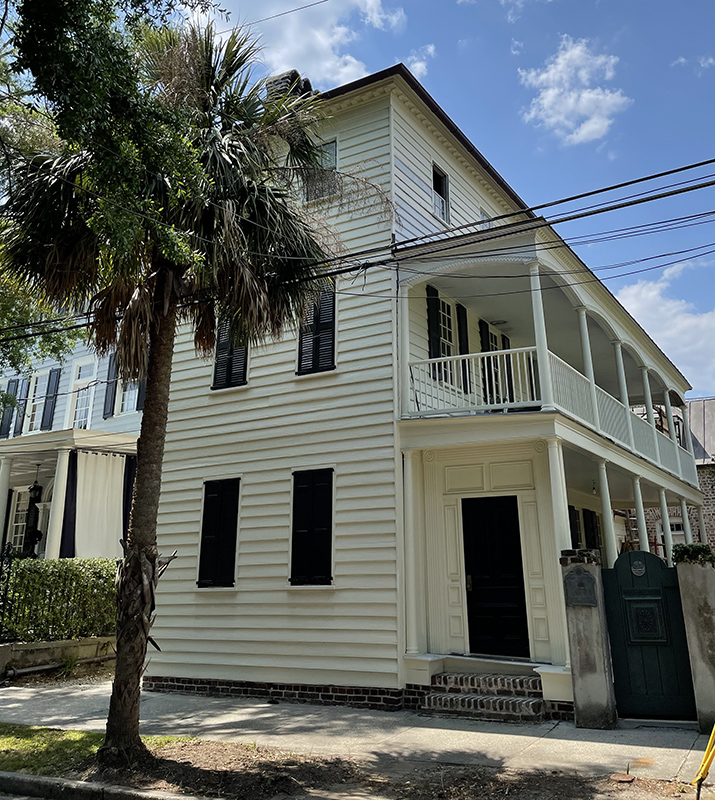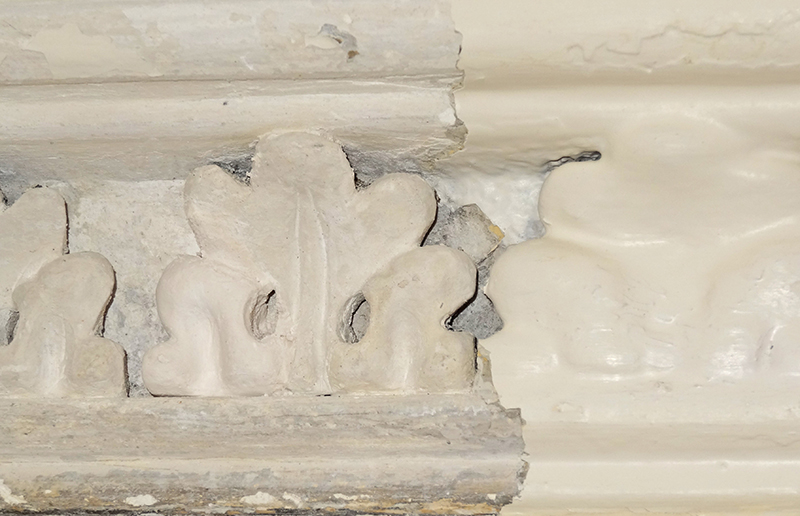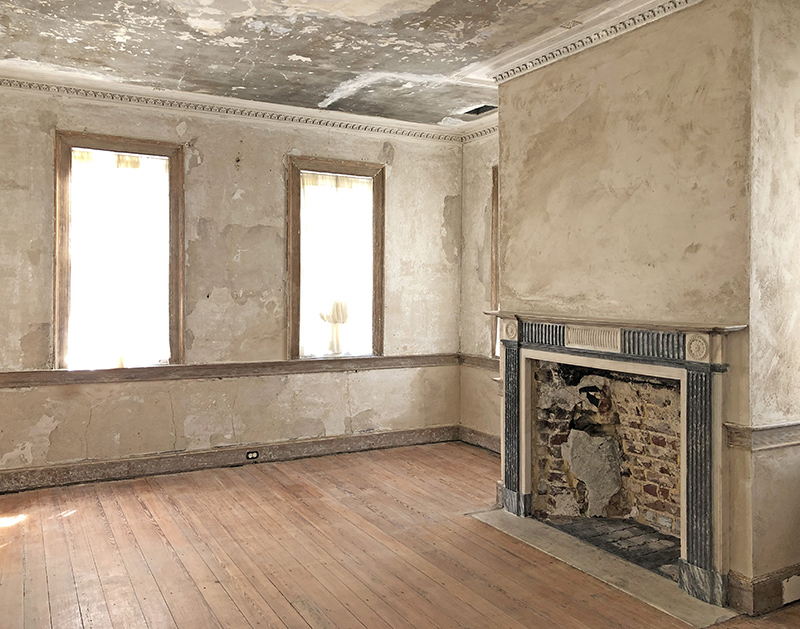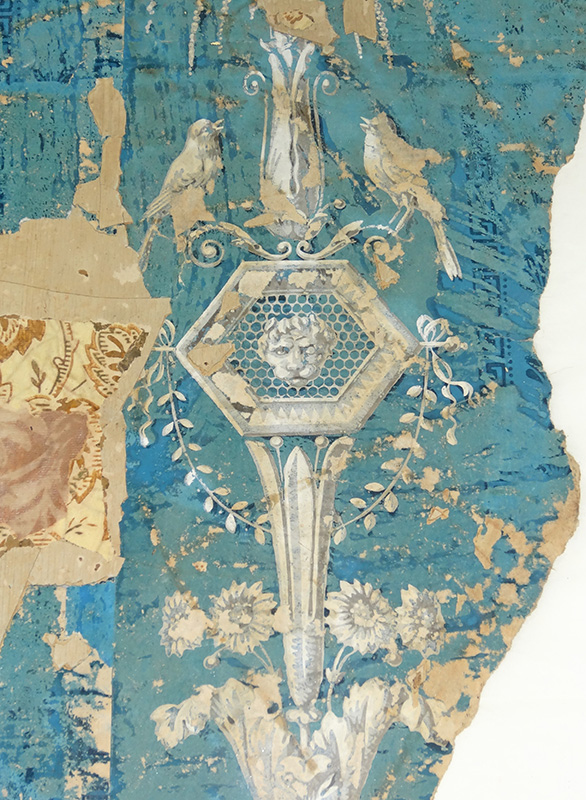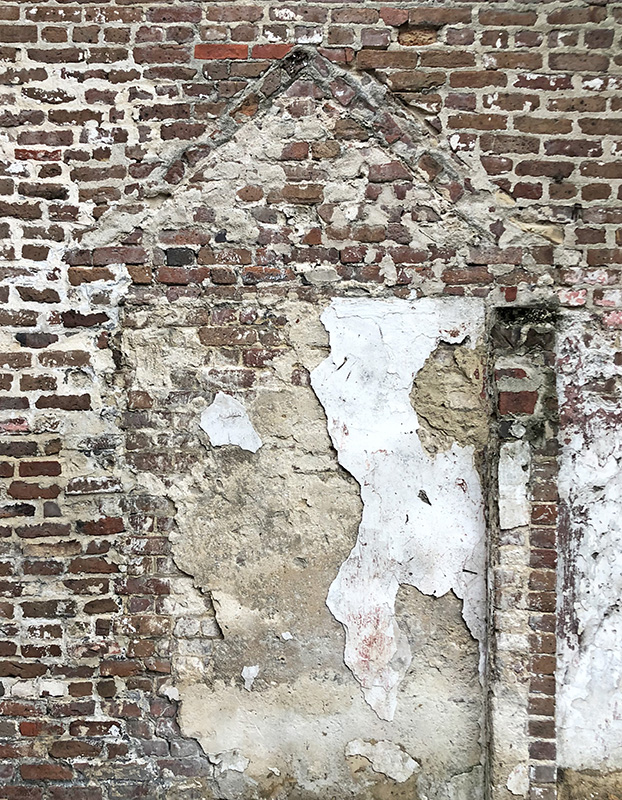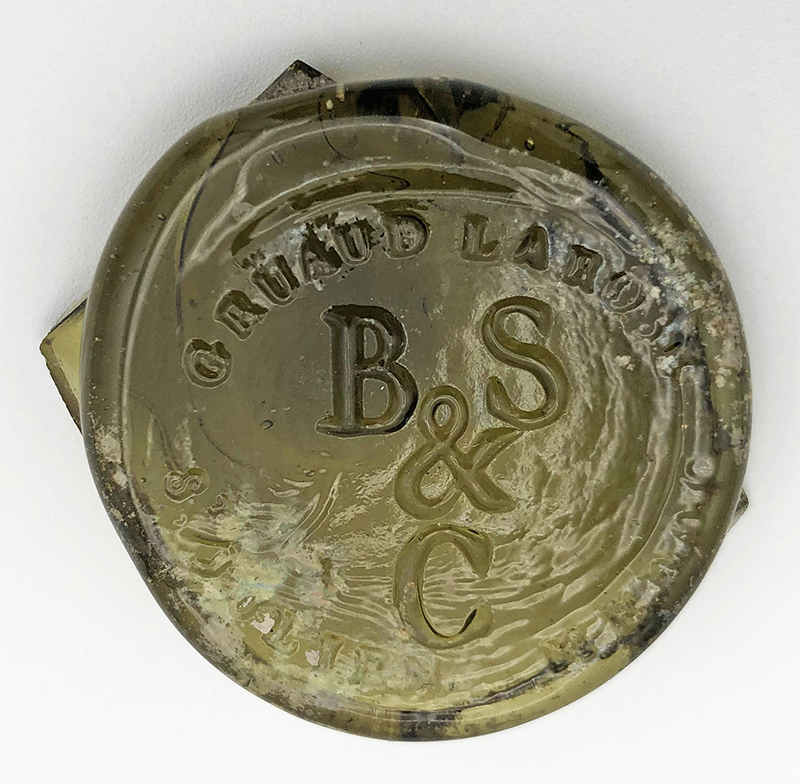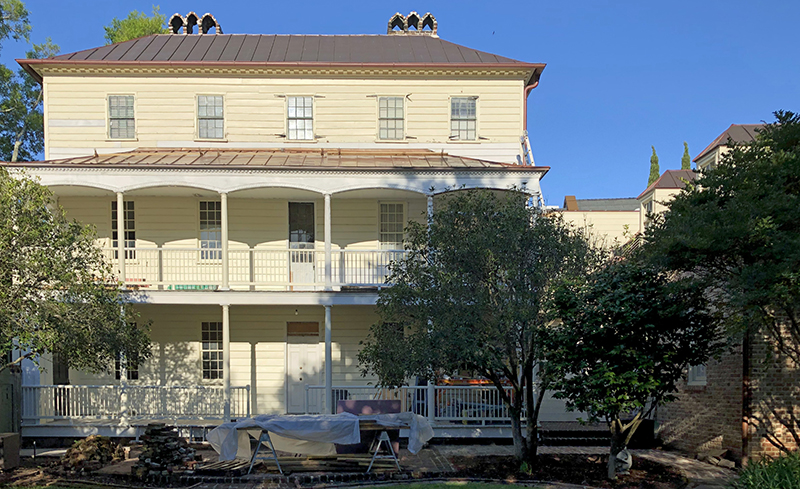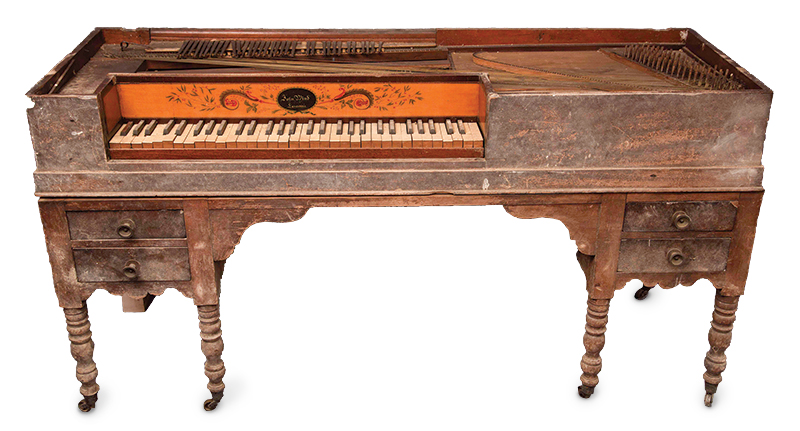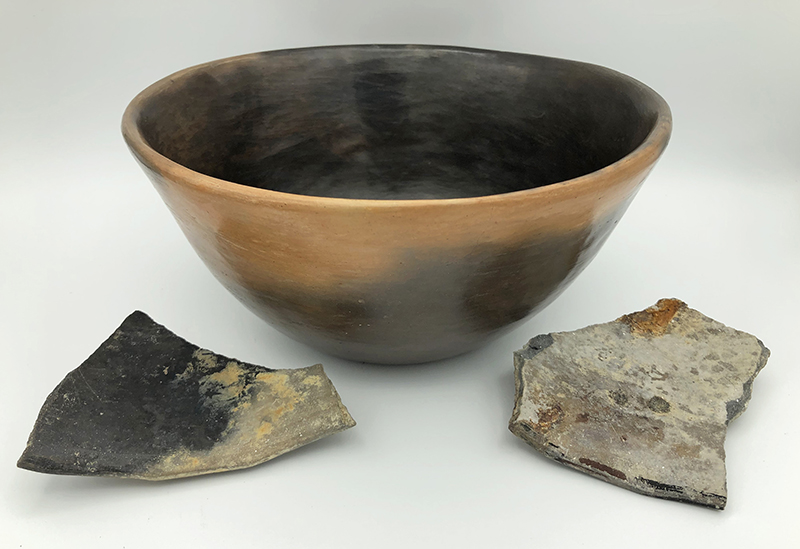Revitalizing Charleston’s Chancognie House: An Accidental Preservationist’s Journey
by Juliana Falk
When I moved to Charleston, SC, in March 2010, seeking a walkable city with less winter weather than Lancaster, PA, I must admit that I did not know much about my new residence beyond what was written on a plaque on the wall: “Simon Jude Chancognie House, c. 1813.” (figure 1). As I later discovered, only half of that inscription turned out to be true.
I was fortunate to meet master restoration contractor David Hoffman shortly after I took up residence. Although I did not suspect it at the time, this introduction proved to be a life-changing event. As we embarked on some much-needed maintenance, David slowly started to teach me about the house and the unique features that had survived remarkably intact over two centuries.
He pointed to the plaster cornice in the upstairs parlor and asked, “Have you ever wondered what is under all that paint?” It had never occurred to me that the cornice might have once looked different than it did that day. David suggested cleaning a small area, and even though I was a bit perplexed as to why he would want to do such a thing, his proposal seemed innocent. Delicate acanthus leaves were revealed under what paint analyst Susan Buck later determined were 23 layers of paint. This discovery was a turning point in my relationship with the house (figure 2).
David believes that the best way to understand a historic structure is to work on it. While I had never considered myself particularly handy, David taught me how to do some of the restoration work myself, starting with removing paint, cleaning plaster, and stripping floors in the upstairs parlor. After a great deal of debate about whether to return the parlor to its original appearance—which would be possible given the evidence of original paint and wallpaper—I decided to keep the room in its current unfinished state to take advantage of the unique opportunity to appreciate the architectural details (figure 3).
My approach to other areas of the house will depend on the evidence of decorative finishes. Susan Buck pinpointed the location of original wallpaper, now in the collection of the Charleston Museum (figure 4), after matching it to fragments found above a door architrave in the stairway. I am working with Colonial Williamsburg Deputy Chief Curator Margaret Pritchard to learn more about the full design of the pattern with plans to have it reproduced using period methods and reinstalled in the stairway. The exterior of the house has been painted to match the original color scheme, and the remaining five rooms of the original house have not yet been studied.
As I learned more about the house, I started to research Chancognie and soon found he was somewhat of an international man of mystery. He was born in the Dordogne region of France in 1769, served as the secretary of the French navy in St. Domingue prior to the outbreak of the Haitian Revolution, was listed in the Baltimore City Directory in 1796, and appeared on the septennial census of Philadelphia in 1800. In 1801, the French consulate in Philadelphia sent Chancognie to Charleston to reopen the consulate, which had closed in 1798 when the Quasi War between the United States and France led to French representatives being expelled from the country.
Chancognie set about making Charleston his home, marrying Marie Susanne Delaire, a French woman from St. Domingue, in 1803, leasing a home on the site of the current Chancognie House in 1805, and purchasing that property from the estate of Christopher Gadsden in 1807. Research too lengthy to document here suggests he built the house that currently stands on the property around 1810, rather than 1813 as indicated on the wall plaque.
The composition of Chancognie’s household is challenging to ascertain. In the 1810 United States census, one white free male and one white free female, both between the ages of 26-44, are listed, with no entries for enslaved or other free persons. In the March 22, 1817, edition of the Charleston City Gazette, an advertisement for the sale of the Chancognie “Household and Kitchen Furniture” included two enslaved persons: a man who was “an excellent cook in the French stile” and a woman who was “an excellent nurse, and fond of children.” At this point, I have not found other evidence of enslaved persons on the property nor that Simon and Marie Susanne had children, but I will continue to research these topics.
Unfortunately, none of the original outbuildings remain. An advertisement for the sale of the property in the January 17, 1813, edition of the Charleston City Gazette contained a list of dependencies: kitchen house “with four servant rooms above,” pantry, stable, wash house and bathing house. I was particularly intrigued by the bathing house, a rare feature for the early 19th century, whose existence can likely be explained by differences in French and American ideas about hygiene at the time.
In order to learn more about the outbuildings, especially the mysterious bathing house, I engaged Martha Zierden, Curator of Historical Archaeology at the Charleston Museum, and Museum Archaeologist Ron Anthony to conduct a week-long dig in March 2016. While I had hoped that the outline of a small building in a wall separating the Chancognie House from the property to the north might have been the bathing house, it turned out to be a former privy that had been previously excavated by privy diggers (figure 5). Despite the disruption to the site, we found an interesting array of artifacts ranging from 18th-century ceramics to 20th-century Lego pieces (see front cover). Although the archaeological record had been destroyed in the privy area, Martha and Ron encouraged me to keep digging. I finally reached the bottom of the privy about two and a half years and eight feet later.
At the outset of the dig, we wondered if there would be a significant number of artifacts of French origin from Chancognie’s ownership of the property (c. 1807–17). Not only were French artifacts lacking, but items of British manufacture were found in abundance. This is largely due to what was available—ceramics make up the majority of the artifacts found here, and during Chancognie’s time much of what was imported into the United States was produced in Britain. Transferware is one of the easier assemblages to classify, and with the help of ceramics scholar Leslie Bouterie, all the patterns that we have identified thus far have been British.
One artifact that can be definitively attributed to France is a glass wine seal from Château Gruaud Larose (figure 6). In addition to holding positions at the consulate in Charleston, Chancognie was a merchant who imported a variety of wares from France, including pickled oysters, silk and cashmere shawls, wigs for men and women, gilt jewelry, bird nets, and sea salt from La Rochelle. He periodically announced the arrival of goods in the Charleston City Gazette, and in an advertisement on May 13, 1816, he offered for sale one dozen bottles of “old St. Julien.” While the manufacturer of the St. Julien wine was not noted, the wine seal found here is marked “Gruaud Larose – St. Julien – Medoc – B S & C.” The “B S & C” refers to a period of ownership of the vineyard by Balguerie, Sarget et Compagnie, which began in 1812 and lasted into the 1860s. With paper wine bottle labels starting to replace glass seals in the early 19th century, there is a strong possibility that this seal came from a bottle of wine that Chancongie imported.
I am often asked what I collect, and one of my projects is to acquire items based on the archaeological findings, focusing primarily on ceramics from Chancognie’s period. Thus far, I have obtained several examples of intact transferware (figure 7) along with a few dipped wares, also known as mochaware, that are similar to fragments found on site—it is notoriously difficult to find exact mocha matches. The thousands of artifacts found thus far, along with any future finds, will remain here, and I plan to create rotating displays of the fragments with their whole counterparts as well as a study collection.
Given the many unique details here at the Chancognie House, another research project is to try to determine who was involved in designing and building the house (figure 8). Since the level of decoration is unusually ornate for a vernacular house, I believe that Chancongie, with his French sense of taste and style, might have had some influence over design decisions. Trying to trace the craftsmen who built the house and whether they were enslaved, indentured, or free is a challenge given the lack of records relating to Chancognie’s time here. He departed for France in 1817 at age 48 and, as far as I have been able to determine, never returned to the United States.
People often ask when the project will be finished, which is an excellent question, and the answer depends on how “finished” is defined. The Chancognie House has been a place for people to call home for over two centuries and, in the next few months, I look forward to transitioning from living in a construction zone to living in a home, albeit one with ongoing research and restoration projects (figure 9). Future plans include studying the landscape, which was noted for fruit trees during Chancognie’s tenure. I will install a c. 1810 John Wind piano forte, in honor of a similar instrument that Marie Susanne had in the house (figure 10), which is currently being restored to playing condition by conservators John Watson and Tom Snyder. I plan to continue working with contemporary Catawba Indian potter Caroleen Sanders to create vessels inspired by historical fragments found here (figure 11), and I hope additional archaeological exploration will determine where the bathing house and other outbuildings stood. Although current zoning codes would likely not allow for their reconstruction, including the building footprints in the landscape might be an option.
I am continually impressed with and appreciative of the support that I have received from the decorative arts and historic preservation communities. I would need another article to acknowledge everyone who has generously shared expertise with me over the years but am especially grateful to David Hoffman for taking a historic house neophyte under his wing and to my parents for their willingness to forego relaxing vacations in favor of helping with projects here, from stripping floors to spending quality time in a former privy.
I would like to thank the Decorative Arts Trust for this opportunity to share some of my adventures at the Chancognie House. If you had tried to convince me 11 years ago that I would someday wield a heat gun, excavate a privy, or write an article for an esteemed decorative arts organization, I would have asked if you had been drinking. The journey has been fascinating thus far, and I cannot wait to see where it takes me next!
Juliana Falk is a graduate of Bryn Mawr College and the University of Virginia School of Law. She documents her journey at the Chancognie House and beyond on her blog theaccidentalpreservationist.com and on Instagram and Facebook as theaccidentalpreservationist.
A print version of this article was published in The Magazine of the Decorative Arts Trust, one of our most popular member benefits. Join today!

